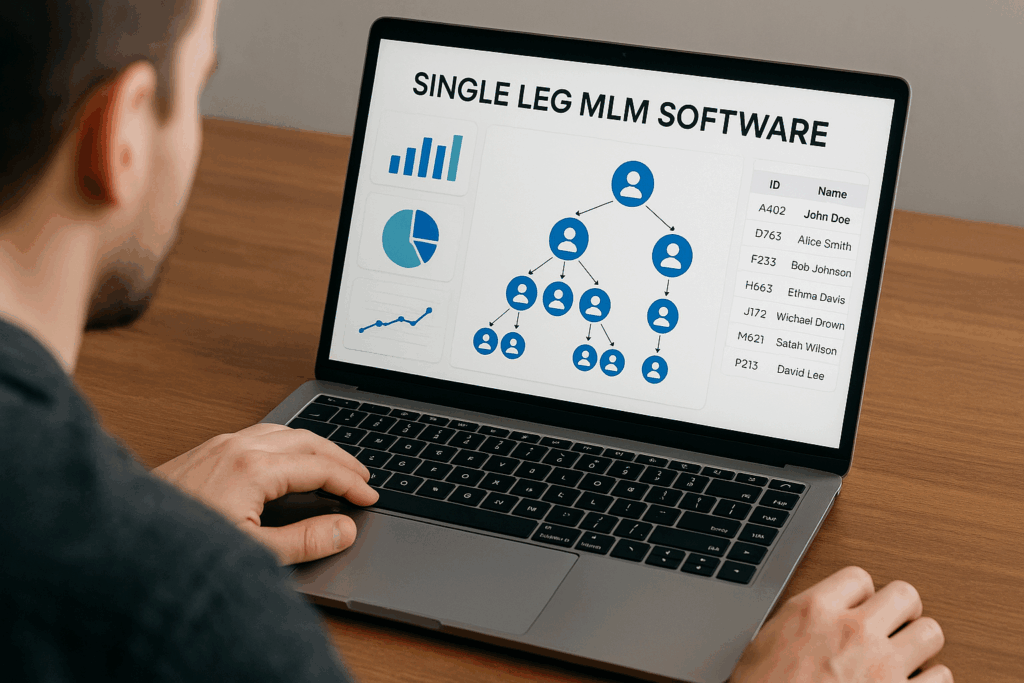Single Leg MLM Software transforms the complex world of network marketing into something refreshingly simple. This specialized system powers what many consider the most beginner-friendly MLM structure – the single leg plan, where everyone lines up in one straight chain regardless of who recruited them.
MLM entrepreneurs, startup founders, and network marketers who’ve struggled with complicated binary or matrix plans will find this guide particularly valuable. Whether you’re launching your first MLM company or switching from a more complex compensation structure, understanding how single leg software actually delivers results can make or break your venture.
We’ll break down the core structure that makes single leg plans so appealing, examine the essential software features that drive real success, and explore the bonus systems that keep distributors motivated and earning. You’ll also discover how commission flows work in practice and why spillover earnings create such powerful passive income opportunities for members at every level.
Understanding Single Leg MLM Plan Structure and Benefits
What Makes Single Leg Different from Binary and Matrix Plans
The Single Leg MLM Software operates on a fundamentally different structure compared to traditional multilevel marketing approaches. Unlike Binary MLM Plans that require members to build and balance two separate legs, or Unilevel Plans that allow multiple frontline members, the Single Leg MLM plan (also known as a Monoline Plan) creates a unified global downline with no competition for placement. This streamlined approach eliminates the complex leg-balancing strategies and strategic placement decisions that often overwhelm newcomers in binary or matrix compensation plans.
The most striking difference lies in the structural simplicity. While binary plans demand careful attention to maintaining balanced growth between left and right legs, the monoline MLM plan arranges all members in a single straight line, one below the other. This unified structure fosters rapid onboarding and enhanced team collaboration since there’s no internal competition for optimal positioning within the network.
How Sequential Placement Creates Equal Opportunities
The Single leg MLM compensation plan operates on a “first-come, first-served” principle that ensures fairness and transparency throughout the network. The MLM software automatically places each new member at the next available spot in the vertical chain, creating sequential progression without manual intervention or favoritism.
This automatic placement system removes the complexity of manual tree management that plagues other MLM commission systems. Network members don’t need to understand intricate placement strategies or worry about optimizing their downline structure. The direct selling software handles all positioning decisions automatically, making the system incredibly easy to understand and ideal for beginners entering the network marketing industry.
The sequential nature creates truly equal opportunities for all participants. Every member, regardless of their recruitment skills or experience level, has the same potential for growth within their position in the line. This eliminates the strategic advantages that experienced marketers might typically hold in more complex compensation structures.
Why Spillover Income Motivates Passive Members
Spillover represents the most compelling feature of Single leg MLM plans, directly addressing one of the industry’s biggest challenges: member retention and engagement. This mechanism allows new members recruited by uplines to be automatically placed beneath existing users, meaning every participant can potentially build a growing team and earn commissions from those positioned below them without requiring personal recruitment efforts.
This passive earning potential creates powerful motivation for inactive or less active members to maintain their participation in the network. Unlike traditional MLM structures where non-recruiters often become discouraged and drop out, the monoline MLM plan ensures that even passive members can benefit from the overall network growth through spillover commissions.
The spillover system contributes to greater earning potential across the entire network while providing ongoing incentives as the company expands. All members, including those who prefer not to actively recruit, can potentially earn from spillovers, significantly reducing dropout rates and increasing the overall stability and retention within the MLM network. This creates a more sustainable business model where the success of active recruiters benefits the entire downline structure.
Essential Software Features That Drive Success

Automated User Placement and Registration Systems
The foundation of any successful single leg MLM software lies in its ability to automatically manage user placement without human intervention. The software seamlessly positions new members at the next available spot in the single line, eliminating the complexity that often overwhelms newcomers to network marketing. This automated placement system ensures continuous downline formation while preventing the placement errors that can disrupt compensation structures.
Modern MLM software incorporates intuitive registration systems that accommodate multiple enrollment methods. New distributors can join through referral links, sponsor IDs, or admin-assigned placement, with built-in email and phone verification processes that establish comprehensive user profiles. This flexibility makes the single leg MLM plan accessible to distributors with varying technical expertise levels.
Each distributor receives unique referral links that serve dual purposes – simplifying the recruitment process while providing valuable analytics. These links automatically track clicks, signups, and conversion data, enabling distributors to analyze their recruitment effectiveness and optimize their marketing strategies.
Real-Time Commission Calculations and Payouts
The computational backbone of effective single leg MLM compensation plan software centers on real-time processing capabilities. The system continuously monitors downline activities, instantly applying commission rules and calculating level-wise payouts and bonuses with mathematical precision. This real-time accuracy eliminates discrepancies and builds distributor confidence in the compensation structure.
Automated payout schedules offer customizable frequency options – daily, weekly, or monthly distributions – with administrators setting minimum thresholds and implementing verification steps like KYC (Know Your Customer) requirements. This automation transforms what was once labor-intensive financial management into streamlined operations that reduce manual data handling while providing distributors with predictable income streams.
Integrated E-Wallet and Payment Gateway Solutions
Every distributor receives a secure personal e-wallet that serves as their financial hub within the network marketing software ecosystem. These digital wallets safely store earned commissions, bonuses, and transferable funds while providing complete transaction transparency through detailed history logs.
The e-wallet functionality extends beyond simple storage, allowing users to withdraw balances, reinvest earnings, purchase company products, or transfer funds to other distributors. Integration with major payment gateways including PayPal, Stripe, Razorpay, and even cryptocurrency wallets ensures distributors can access their earnings through their preferred financial channels, enhancing the overall user experience and financial convenience.
Advanced Admin Dashboard for Complete Control
The administrative control center provides comprehensive oversight through a secure, centralized interface that monitors all MLM commission system operations in real-time. Administrators gain instant visibility into user growth metrics, downline hierarchies, detailed commission reports, payout statuses, sales performance data, and bonus distributions.
The dashboard incorporates intelligent alert systems and notification features that keep administrators informed of critical developments, while report export capabilities and role-based access controls ensure informed decision-making across different management levels. Mobile-responsive design extends this functionality to smartphones and tablets, enabling both distributors and administrators to monitor team growth, track earnings, and manage their monoline MLM plan operations regardless of location or device.
Bonus Structures That Maximize Distributor Earnings

Referral Bonuses for Direct Recruitment Rewards
Referral bonuses form the cornerstone of Single Leg MLM Software compensation structures, serving as fundamental incentives that reward distributors for expanding the network. These bonuses are triggered when a user successfully refers a new member using their unique referral link or sponsor ID, creating a direct connection between recruitment efforts and immediate financial rewards.
The Single leg MLM plan processes these bonuses with remarkable efficiency, paying them immediately upon successful registration or package purchase by the new recruit. This instant gratification model operates through two primary structures: fixed-amount bonuses that provide consistent rewards regardless of package size, or percentage-based bonuses that scale with the new member’s package value. This flexibility allows MLM companies to tailor their compensation approach based on their specific business model and target market.
What makes referral bonuses particularly powerful in monoline MLM plan structures is their unlimited earning potential. Since sponsors can earn bonuses from every direct referral they bring into the system, there’s no cap on the number of bonuses a distributor can receive. This design encourages active recruitment and sustained front-line engagement, making it an essential component of any effective MLM commission system.
Matching Bonuses Based on Team Performance
Moving beyond direct recruitment rewards, matching bonuses create a sophisticated layer of compensation that ties sponsor earnings directly to their team’s overall performance. When a downline member earns income through commissions or other bonus structures, their sponsor automatically receives a predetermined percentage of that income as a matching bonus.
This Network marketing software feature operates across multiple levels within the organization, fostering a culture of mentorship and continuous support. Sponsors become genuinely invested in their team members’ success because their own income directly correlates with their downline’s achievements. The matching bonus system effectively transforms sponsors into coaches and mentors, as their financial success depends on developing and supporting their team members.
Most Single leg MLM compensation plan implementations include strategic limitations on matching bonuses through rank progression requirements, activity thresholds, or caps on the number of active referrals that qualify for matching bonuses. These restrictions ensure the compensation plan remains sustainable while still providing meaningful incentives for team development.
The automatic nature of matching bonus calculations within modern MLM software means that whenever a distributor receives any type of bonus—whether referral, rejoin, or commission-based—their sponsor immediately receives their corresponding matching bonus without any manual intervention.
Rejoin Bonuses for Long-Term User Retention
The rejoin bonus, also recognized as a cycle or reactivation bonus, addresses one of the most critical challenges in network marketing: maintaining long-term distributor engagement and preventing account dormancy. This sophisticated retention mechanism activates when distributors reactivate old accounts, repurchase plans, or complete designated income cycles within the Single Leg MLM Software.
These bonuses serve multiple strategic purposes beyond simple reactivation rewards. They encourage continued participation from distributors who might otherwise become inactive, effectively breathing new life into dormant accounts. The rejoin bonus structure is particularly effective in loop or cycling plans where distributors progress through multiple earning cycles throughout their participation.
Direct selling software implementations handle rejoin bonuses through flexible distribution mechanisms. The bonus can flow to the original sponsor, maintaining the established sponsor-downline relationship, or contribute to a re-entry spillover strategy that benefits the broader organization. This flexibility allows companies to align their retention strategy with their overall compensation philosophy and growth objectives.
The long-term impact of rejoin bonuses extends beyond individual reactivation events. By creating financial incentives for continued participation, these bonuses contribute to overall network stability and MLM downline growth, ensuring that the single leg structure maintains its momentum over extended periods.
How Commission Flow Works in Practice
First-Come-First-Served Compensation Model
The Single Leg MLM compensation plan operates on a fundamental “first-come, first-served” principle that forms the backbone of its commission structure. This approach ensures that upline distributors receive direct financial rewards from the activity of their downlines, creating a streamlined earning mechanism within the Single leg MLM plan.
In this model, new members are systematically placed in a single line beneath the previous member, creating a linear downline structure. When these newly enrolled distributors pay enrollment fees or make product purchases, their financial activity directly contributes to commissions and bonuses for those positioned higher in the line. This MLM commission system ensures that early adopters and active participants benefit as the network expands vertically.
The beauty of this approach lies in its simplicity and transparency. Active distributors can demonstrate potential earnings to new recruits by showcasing how the collective downline contributes to their income. This creates a compelling recruitment tool while maintaining the integrity of the monoline MLM plan structure.
Level-Based Payout Distribution Systems
Now that we understand the basic compensation model, let’s examine how Single Leg MLM Software calculates and distributes commissions through sophisticated level-based payout systems. These systems enable distributors to earn from activities of members positioned deep within their downline, extending earning potential far beyond direct recruits.
Most MLM software implementations require distributors to sponsor a predetermined number of individuals before becoming eligible for commission payouts. Typically, companies set this threshold at 2 or 3 direct sponsorships, ensuring distributors demonstrate basic recruiting activity before accessing the full compensation structure.
The payout percentages follow a tiered approach that varies based on the relationship to the earning distributor:
- Direct recruits: Higher commission rates (commonly 10%)
- Downline members: Reduced percentages (typically 5%)
- Deep downline: Further graduated reductions
This Single leg MLM compensation plan structure allows companies to customize earning conditions based on their specific business model and market requirements. The flexibility ensures that different organizations can implement varying compensation structures while maintaining the core single-leg framework.
Spillover Benefits for Non-Recruiting Members
Previously, we’ve seen how active recruiters benefit from the commission structure. With this in mind, next, we’ll explore one of the most attractive features of Single Leg MLM Software – the spillover benefit system that supports non-recruiting members.
Spillover functionality automatically places new members recruited by uplines beneath existing distributors in the single line, regardless of whether those distributors actively participated in the recruitment process. This means passive or less active members can still generate commission income from the purchases and activities of users placed below them through this automated placement system.
This spillover income serves multiple strategic purposes within the Network marketing software ecosystem:
| Benefit | Impact |
|---|---|
| Member Retention | Passive earners remain engaged longer |
| Network Stability | Reduces attrition rates across the organization |
| Motivation Maintenance | Non-recruiters see tangible benefits |
| Growth Acceleration | Encourages continued participation |
The spillover mechanism creates a supportive environment where even distributors who struggle with recruitment can experience success through the collective efforts of their upline. This feature significantly contributes to higher retention rates and overall network stability within the One leg MLM plan structure, making it an essential component of effective direct selling software implementations.
Key Advantages That Make Single Leg Plans Attractive
Simplified Structure Reduces Training Requirements
The single leg MLM plan’s straightforward architecture represents one of its most compelling advantages for both MLM companies and distributors. Unlike complex binary or matrix plans that require extensive understanding of balancing and positioning strategies, the single leg MLM compensation plan operates on a simple one-line structure with no branching complications. This streamlined approach eliminates the confusion and technical errors commonly associated with placement decisions in multi-leg systems.
The beauty of this monoline MLM plan lies in its intuitive nature – new distributors can quickly grasp the concept without requiring weeks of intensive training. The elimination of complex tree-building strategies means that companies can significantly reduce their educational overhead while accelerating the onboarding process. This simplicity translates directly into cost savings and faster market penetration for organizations implementing single leg MLM software.
Unlimited Growth Potential Without Balancing Issues
One of the most significant operational advantages of the single leg MLM plan is its automated placement system that supports rapid team expansion without the traditional balancing constraints. The software automatically places all new recruits in one unified line, creating a seamless growth environment that benefits the entire network. This automation is particularly valuable for fast-growing teams and startup organizations that need scalable MLM commission systems.
The collective growth model inherent in single leg structures generates natural excitement and urgency among distributors. Since all members contribute to one downline, the success of each individual directly impacts the entire team’s earning potential. This unified approach to MLM downline growth eliminates the frustration of maintaining balanced legs while maximizing the network’s overall momentum and productivity.
Passive Income Opportunities Increase Retention Rates
The spillover mechanism within single leg MLM software creates unique passive income opportunities that significantly impact distributor retention. Even members who are not actively recruiting can benefit from the activities of others placed below them in the single line structure. This spillover effect ensures that passive or less active distributors remain motivated and engaged with the network.
This passive earning potential addresses one of the most critical challenges in network marketing – member dropout rates. When distributors see consistent income flowing from the efforts of their downline, regardless of their personal recruiting activity, they are far more likely to maintain their membership and continue supporting the network. The direct selling software facilitates this automatic distribution, creating a stable foundation for long-term network growth and sustainability.
Beginner-Friendly Model Accelerates Onboarding
The single leg plan’s beginner-friendly nature makes it an ideal choice for individuals new to network marketing software and MLM concepts. Unlike complex compensation plans that require strategic thinking about team building and leg balancing, the one leg MLM plan operates as a straightforward plug-and-play system. New distributors don’t need to develop sophisticated recruiting skills or understand intricate placement strategies to begin earning.
This accessibility factor makes the single leg model particularly attractive for MLM companies targeting broader demographics or entering new markets. The reduced management overhead and simplified explanation process allow companies to onboard new distributors more efficiently while providing them with immediate earning opportunities. The cost-effectiveness of this approach, combined with the robust capabilities of modern single leg MLM software, creates an optimal environment for both company growth and distributor success.
Potential Challenges and Risk Management

Preventing Member Inactivity Through Smart Incentives
A significant challenge facing Single Leg MLM Software implementations is the “passive culture risk” where members become inactive recruiters due to spillover benefits. The single leg MLM plan structure can inadvertently promote inactivity as members earn commissions without personal recruitment effort, potentially slowing overall network growth. This creates a sustainability concern for MLM companies relying on consistent distributor engagement.
To ensure long-term success, Single Leg MLM Software must incorporate smart limits and performance-based incentives that balance spillover-driven retention with active participation. These systems should require minimum personal recruitment quotas or sales volumes to qualify for spillover commissions. The MLM commission system can include progressive bonus structures that reward active members with higher commission rates, creating motivation for continuous engagement rather than passive income collection.
Managing Higher Payouts as Networks Expand
Network marketing software for single leg MLM plans faces the critical challenge of managing escalating commission costs as membership grows exponentially. Without carefully defined conditions on commissions, companies risk excessive spending that can lead to declining profit rates as the network expands. This financial pressure intensifies because the monoline MLM plan structure creates a concentrated payout system where commissions flow through a single line.
The Single Leg MLM Software must implement robust financial controls and commission caps to prevent unsustainable payout scenarios. Direct selling software should include automated monitoring systems that track commission ratios against revenue, ensuring profitability remains viable even with rapid network growth.
Addressing Fairness Concerns Between Early and Late Joiners
The “first-come-first-served” nature of the One leg MLM plan creates inherent disparities between early and late joiners, potentially demotivating newer participants. Early members naturally achieve higher earnings due to their positioning advantage in the single leg structure, which can create perceptions of unfairness regarding income distribution.
This unbalanced nature poses significant management challenges for MLM companies implementing Single Leg MLM compensation plans. The software must address these fairness concerns through features like periodic restructuring opportunities, achievement-based positioning adjustments, or additional bonus pools that reward performance over placement timing. These mechanisms help maintain distributor motivation across all membership levels while preserving the fundamental benefits of the monoline structure.
Implementation Considerations for MLM Companies
Customization Options for Unique Business Models
Single Leg MLM software providers recognize that every MLM business has distinct requirements, which is why they offer highly customizable solutions. Companies can define unique commission structures that align with their specific compensation strategy, whether they prefer percentage-based payouts, flat-rate bonuses, or hybrid models. The software allows for complete customization of bonus types, enabling businesses to create rank-based income conditions that motivate distributors at different levels of achievement.
The customization extends far beyond basic commission structures. Companies can configure specific payout logic that determines when and how distributors receive their earnings, ensuring alignment with business cash flow and growth objectives. KYC (Know Your Customer) and withdrawal rules can be tailored to meet specific business requirements and regulatory demands, providing flexibility while maintaining security standards.
Branding elements represent another crucial customization aspect, allowing companies to incorporate their logos, color themes, and preferred languages throughout the platform. This ensures the Single Leg MLM Software accurately reflects the company’s brand identity and creates a cohesive user experience. Custom development capabilities ensure the MLM software can scale effectively as the network experiences growth, accommodating increasing user volumes and transaction loads without compromising performance.
Legal Compliance and Regulatory Requirements
The legal landscape surrounding MLM operations requires careful attention to compliance standards. Single Leg MLM software operates within legal boundaries when it supports compliant MLM models that offer genuine products or services to end consumers. The software must facilitate clear income disclosures, ensuring distributors understand earning potential and limitations rather than relying solely on recruitment-based earnings.
Adherence to national laws and MLM regulations varies by jurisdiction but remains non-negotiable for successful operations. In the United States, FTC guidelines mandate specific disclosure requirements and prohibit pyramid scheme structures. Similarly, Consumer Protection laws in India establish frameworks that MLM companies must follow to maintain legal status.
The monoline MLM plan structure supported by Single Leg MLM software can facilitate compliance when properly implemented, as it encourages product sales alongside team building activities. Network marketing software must include features that track product sales, maintain proper documentation, and generate compliance reports that demonstrate adherence to regulatory requirements.
Mobile Integration and User Experience Features
Modern Single Leg MLM Software platforms prioritize mobile accessibility through responsive dashboards and dedicated mobile applications. These mobile solutions enable distributors and administrators to manage their MLM business operations from anywhere, providing real-time access to critical business metrics and team performance data.
Mobile integration includes comprehensive functionality that allows users to track team growth patterns, view detailed earnings summaries, and monitor commission system performance. Distributors can easily share referral links through social media platforms, check wallet balances in real-time, and access detailed commission reports that provide insights into their One leg MLM plan performance.
The user experience features extend to administrative functions, enabling MLM companies to manage their direct selling software operations remotely. Mobile accessibility enhances convenience for managing network marketing activities, supporting the rapid pace of modern MLM operations where distributors need instant access to information and earning opportunities.
Cost Factors and ROI Expectations
Investment in Single Leg MLM Software varies significantly based on specific business requirements and feature complexity. The average cost ranges from $500 to over $5,000, with pricing influenced by factors including supported user capacity, custom feature development, branding requirements, payment gateway integrations, and ongoing technical support services.
Several vendors offer flexible monthly subscription models, making MLM commission system technology accessible to businesses with varying capital constraints. This pricing structure allows companies to scale their investment as their network grows, managing cash flow more effectively during initial growth phases.
The Single leg MLM compensation plan is considered highly cost-effective compared to more complex MLM structures, making it particularly attractive for startup companies entering the network marketing industry. The simplified structure reduces development complexity and ongoing maintenance costs, while the rapid growth potential inherent in MLM downline growth creates strong ROI expectations. Companies typically see positive returns as their distributor networks expand and transaction volumes increase, justifying the initial software investment through sustained revenue generation.
Single Leg MLM software succeeds because it transforms complexity into simplicity. By automating user placement, commission calculations, and spillover distribution, it eliminates the strategic headaches that plague other MLM structures. The combination of referral bonuses, matching bonuses, and rejoin incentives creates multiple earning streams while the first-come-first-served model rewards both active recruiters and passive participants through spillover benefits.
The real power lies in balancing accessibility with sustainability. While the unlimited earning potential and beginner-friendly structure make it attractive for startups and new distributors, success depends on implementing smart qualifying conditions and performance incentives to prevent over-reliance on passive income. For MLM companies seeking rapid growth with minimal administrative overhead, Single Leg software offers a plug-and-play solution that scales efficiently while maintaining distributor motivation and network stability.



